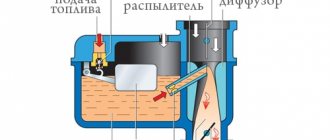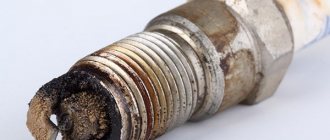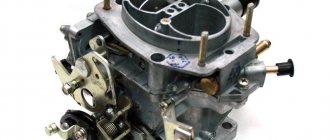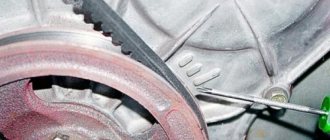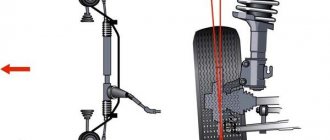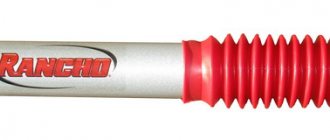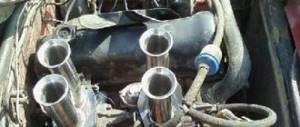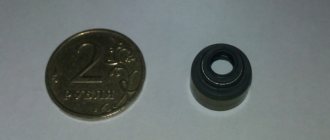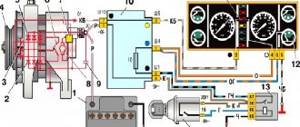The fuel system of a car consists of various components and parts that can perform similar functions. For the engine to operate, a fuel supply system is needed, and the solution to such problems is to install a carburetor or injector. Although these devices have fundamental differences in design, their task is to prepare a combustible mixture. Depending on the car model, one of these systems is installed, and it is quite simple to find out the difference between an injector and a carburetor.
Carburetor - is the simplest type of device for supplying and spraying gasoline. The process of mixing fuel with air is performed mechanically, and adjusting the supply of the mixture requires careful adjustment. Thanks to the use of simple mechanisms, the carburetor system is easy to maintain. An experienced motorist can perform such repairs independently, which provides certain advantages in operation. For such operations, it is not difficult to purchase a repair kit, and all work is carried out with standard tools available in the car.
The carburetor is located on the intake manifold, and its design consists of a float and mixing chambers. To supply fuel, a spray tube is used, connecting the chambers to each other. Fuel is supplied to the float chamber using a gasoline pump, and a stable supply of gasoline is ensured by a needle filter and a float. The mixing chamber is also called the air chamber and consists of a diffuser, atomizer and throttle valve. When the pistons move, a vacuum is created, which ensures the suction of atmospheric air and gasoline. This mixing ensures stable engine operation.
Economizer
It is also an extremely necessary part of the carburetor, and both a single-chamber carburetor and a two-chamber carburetor are unthinkable without it. The task of the economizer is to provide the engine with even more oxygen-rich fuel. This need arises when loads increase, for example, to develop speeds above 110 km/h. At the moment of a sharp increase in such speed, the throttle valves open as much as possible, and the supply of the air-fuel mixture increases to the maximum. To speed up this process and give the engine the necessary acceleration, professionals resort to using a device such as a carburetor accelerator pump. It allows you to bring the procedure to maximum levels, as a result of which the engine will receive enriched fuel in a matter of milliseconds.
A little history
Early developments at the dawn of the engine building era used lighting gas as fuel. At an early stage, such engines simply did not need a carburetor. The illuminating gas entered the cylinders due to the vacuum that was formed during engine operation. The main problem with such fuel was its high cost and a number of difficulties during use.
We recommend: Is it possible to mix Tosol and antifreeze?
The second half of the 19th century was the period when inventors, engineers and mechanics all over the world tried to replace expensive lighting gas with a more economical, cheaper and accessible type of fuel for the internal combustion engine. The best solution was to use liquid fuel that is familiar to us today. It is worth considering that such fuel cannot ignite without the participation of air.
To prepare a mixture of air and fuel, an additional device was required. Not only that, but it was also necessary to mix air with fuel in the required proportions. To solve this problem, the first carburetor was invented. The device was released in 1876. The creator of an early model of the carburetor was the Italian inventor Luigi De Christoforis. In its design and operating principle, the first carburetor had a number of significant differences from more modern analogues.
To obtain a high-quality fuel-air mixture, the fuel in the first device was heated, and its vapors were mixed with air. For a number of reasons, this method of forming a working mixture is not widely used. Developments in this area continued, and a year later, talented engineers Gottlieb Daimler and Wilhelm Maybach created the design of an internal combustion engine that had a carburetor operating on the principle of fuel atomization. This device formed the basis for all subsequent developments.
What is a carburetor
The need to develop an automatic device that regulates the creation of an air-fuel mixture arose at the end of the 19th century. Previously common cars ran on lamp gas, which is highly flammable. However, such fuel was too expensive and inconvenient, so the designers decided to switch to liquid analogues.
However, to ignite it, it must be mixed with air in special proportions. So the best engineering minds set about developing the carburetor. The first model was presented by Luigi De Christoforis. It did not become widespread, but became the basis for further developments.
We recommend: How to change the oil in an automatic transmission Polo sedan
Over decades of further improvement, three basic types of carburetors were developed: membrane-needle, bubbler and float. True, in the second half of the 20th century the latter began to be used almost everywhere. In particular, they were installed on domestic cars until the 1990s.
Carburetor control
As a rule, the actions of the carburetor are controlled by the driver of the car. Some models of carburetors used auxiliary systems that slightly automated carburetor control.
In order to control the throttle valve, the gas pedal is most often used, which determines its mobility with the assistance of a rod system or cable drive. Traction is usually better, but the drive mechanism is much more complex and hinders the mechanism’s ability to arrange the engine compartment area. Rod drive was popular until 1970, then metal cables began to be used more often.
On older cars, a dual carburetor throttle valve drive system was often assumed: manually using a lever or from the foot using a pedal. If you press on the pedal, the lever does not move, but if you move the lever, the pedal goes down.
Subsequent opening of the throttle can be done using the pedal. When the pedal is lowered, the throttle remains in the same position in which it was fixed when controlled by hand. For example, on the Volga GAZ-21, a lever was placed on the instrument panel to control the hand; by moving it, you can achieve constant operation of a cold engine without the action of the air damper, or use “constant gas”. On trucks, "constant throttle" was used to make reversing easier.
We recommend: Fuel filter for diesel engine
The air damper can be equipped with a mechanical or automatic drive. If the drive is mechanical, then the driver closes it using a lever. The automatic drive is very popular in other countries, but in Russia it has not “taken root” due to its unreliability and short service life.
Advantages of a carburetor
The carburetor fuel supply system has undergone decades of testing and has the right to count on the attention of drivers. Its main advantage is the ability to repair it in almost any unforeseen situation far from a service center. The advantages and differences of this technology are easy to see from the following indicators:
- Lower cost of the device and its operating costs;
- Lack of carbon deposits and relative undemanding requirements for fuel;
- Easy to repair and low cost of services;
- Using the engine to suck in fuel.
This is interesting: To understand the process, consider the principle of operation of the mechanism
The carburetor is sensitive to temperature conditions. Extreme heat or freezing temperatures can make it difficult to start the engine. It is worth noting that the carburetor is considered an outdated technology and does not meet EURO 3 requirements.
Main dosing system
This system allows you to clearly separate and dose the amount of fuel entering the engine while driving at average speed. It includes elements such as:
- Fuel jets;
- Main distributor;
- Diffuser.
In this case, the main fuel supply nozzle is located in a specially drilled channel between the float chamber and the main air nozzle, consisting of a small tube with holes for air supply. The main jet is responsible for what ratio the fuel will have when mixed with air.
Car carburetor parts
At the same time, the design of the carburetor is such that to calibrate it, you can install jets with different cross-sections when setting various operating modes of the carburetor.
The design of a simple carburetor
The main task of the carburetor is to mix the air flow with gasoline in certain proportions. Then all this is fed into the combustion chamber in the cylinder block, where the composition burns during the power stroke of the piston. The released energy pushes the piston mounted on the crankshaft, and thus the energy of the explosion of the fuel is converted into mechanical rotational energy.
To carry out the process, the carburetor is connected to the fuel pump, the air supply system and the inlet pipes of the cylinder block. The simplest device has only two chambers: mixing and float. The formation of the mixture occurs throughout the entire period from air suction to injection into the chamber.
First, gasoline is sprayed into the mixing chamber. This is done using a spray tube leading into a diffuser (tapering channel). The feed rate in it increases, forming a vacuum. Due to this vacuum, gasoline is sucked out of the diffuser, mixing with air.
Fuel flows through a channel connected to the float chamber. A limiting nozzle (a cylinder with a small hole along the axis) is fixed inside the channel, which meters the supply of gasoline from the float chamber.
Comparison of mono injection and carburetor system
Mono-injection is one of the types of electronic fuel injection systems into the engine. We can say that single-injection systems are a kind of transitional model from a carburetor to an injector.
For the first time, mono-injection was developed and installed for aircraft as a more modern modification of the carburetor unit, which eliminated “failures” in the fuel supply during the performance of figures in the air.
We recommend: What is a tow bar - purpose, types, electrical, production
A significant difference between a mono-injection and a carburetor system can be considered the presence in a mono-injection device of a computer unit for controlling the supply and consumption of fuel, as well as a gasoline pump and one injector powered by electricity. The mono-injection type of operation is similar to a carburetor, only using more modern components.
The main advantage of the mono-injection system is the uninterrupted operation of the engine, since a minimum pressure of 1 bar is constantly maintained in the unit. That is, vehicles with single injection can operate uninterruptedly during sudden overtaking or braking, when carburetor mechanisms cannot always guarantee engine stability in these modes.
In addition, mono-injection guarantees an increase in the power of the power unit due to the absence of power failures.
However, carburetors are still considered more economical devices to this day, since fuel injection is carried out not at one point, but throughout the entire chamber, which allows the entire incoming volume of fuel to be used. For this reason, engines with carburetors are easier to start in winter.
Thus, carburetor devices have good characteristics in terms of economical fuel consumption and the ability to start in any climatic conditions. Single injection ensures more stable engine operation and high quality vehicle power.
Carburetor and injector
Further in the history of fuel supply and mixture formation systems, monoinjection (monoinjector) first appeared, and fully electronic injection and high-performance fuel injectors finally replaced obsolete carburetors.
The main advantage of the injector is much more accurate and timely dosing of fuel to obtain the required proportions of the fuel-air mixture. The emergence and introduction of affordable microprocessors into the auto industry ultimately led to the fact that the need for a complex carburetor and additional devices in its design simply disappeared. All the functions of the individual elements of the carburetor were taken over by one single control unit (ECU), and simple design devices were installed in the injector design.
It is a mistake to believe that an injector is a more economical solution compared to a carburetor. A well-tuned carburetor demonstrates similar fuel consumption indicators. The popularity of distributed injection is due to the fact that this particular fuel supply mechanism is capable of meeting all stringent modern standards and requirements for the environmental friendliness of internal combustion engines. The carburetor cannot satisfy such requirements, which is due to its design features and the performance of the jets.
Today, carburetor injection is found only on those engines whose main purpose is the target installation on special equipment. The reason for this decision was the vulnerability of electronic injection systems during harsh operating conditions. Electronic components and injector modules suffer from increased humidity and contamination, and injectors are sensitive to fuel quality. As an example, it is worth saying that it is definitely better to install a mechanical carburetor on a special vehicle when using it in swamps, which will not burn out. Such a carburetor can always be easily maintained, cleaned and dried if necessary.
Types of carburetors
As we have already said, the process of modernizing carburetors has generated a large number of types of this device from different manufacturers. All this variety of carburetors can be divided into three groups:
- bubbling;
- membrane-needle-shaped;
- float;
The first two types of carburetors have practically not been seen for a long time, so we will not dwell on these designs. It is more advisable to consider a float carburetor, which can still be seen in various modifications on civilian cars of the 90s era today.
Float carburetor design
The main job of a carburetor is to mix fuel and air. Different models of carburetors carry out this process according to a similar principle. The float carburetor consists of the following elements:
- float chamber;
- float;
- float lock needle,
- jet;
- mixing chamber;
- spray;
- Venturi tube;
- throttle valve;
The float carburetor is designed in such a way that a special line is connected to its float chamber. This line supplies fuel from the fuel tank to the carburetor. Regulation of the amount of fuel in the chamber is carried out through two elements that are interconnected. We are talking about a float and a needle. A drop in the fuel level in the float chamber means that the float will drop along with the needle. Thus, it turns out that the lowered needle will open access for the next portion of fuel to enter the chamber. When the chamber is filled with gasoline, the float will rise, and the needle will simultaneously block access to fuel.
At the bottom of the float chamber there is the next element called a jet. The nozzle acts as a calibrator and ensures dosing of the fuel supply. Through the nozzle, fuel enters the atomizer. This is how the required amount of fuel moves from the float chamber to the mixing chamber. The process of preparing the working fuel-air mixture takes place in the mixing chamber.
Structurally, the mixing chamber has a diffuser. This element is designed to increase air flow speed. The diffuser is responsible for creating air vacuum in the immediate vicinity of the sprayer. This helps draw fuel out of the float chamber and also helps to atomize it better in the mixing chamber. This is the basic design of a simple float carburetor.
Throttle: cold start and idle
The amount of working fuel-air mixture that enters the engine cylinders will depend on the position of the throttle valve. The damper has a direct connection with the gas pedal. But that is not all.
Some cars with a carburetor had an additional device to control the throttle valve. This element is well known to fans of the old “classics” from VAZ. Motorists popularly nicknamed this device “suction”, and the device itself was created for cold starting. The element is made in the form of a special lever, which is located at the bottom of the dashboard on the driver's side.
The lever allows you to additionally control the throttle valve. If you pull the “choke” towards you, then the damper closes. This allows you to limit air access and increase the level of vacuum in the carburetor mixing chamber.
At increased vacuum, gasoline from the float chamber is drawn into the mixing chamber much more intensely, and the insufficient amount of incoming air forces the carburetor to prepare a rich working mixture for the engine. It is this mixture that is best suited for confidently starting a cold engine.
It is worth noting that the first in the entire design to undergo further modernization was the cold start, already familiar to us under the name “suction”. The simplest carburetors deservedly include the once widespread and popular Solex carburetor, to which the line of classic VAZ cars owes a lot.
The operation of a carburetor engine in idle mode is as follows:
- The carburetor is equipped with special additional air jets. These jets are responsible for supplying a strictly dosed amount of air;
- the air passes under the throttle valve and is then mixed with gasoline according to the working algorithm. In this case, the entire process occurs when the gas pedal is not depressed and released;
This is what the basic device and operating principle of a float-type carburetor looks like.
